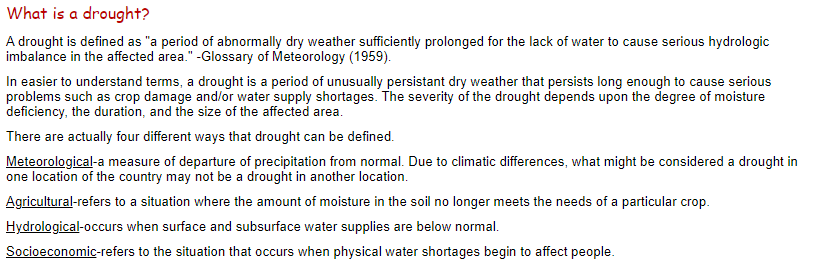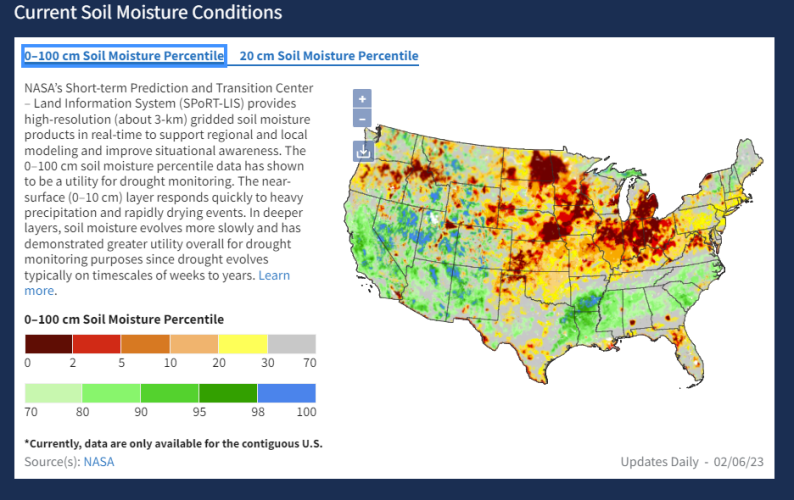antlerradar
Well-known member
That drought map doesn't look too bad when you compare it to maps not that long ago.
Follow along with the video below to see how to install our site as a web app on your home screen.
Note: This feature may not be available in some browsers.
I think it’s was just that much drought. California was the dark red before the huge storm dump all that rain and caused all that flooding. They are still in a drought but not that bad. I think we still need a lot more snow/rain to get back to normal.Idk... hard to reconcile the two
View attachment 263262
I mean NW Nevada is 150% normal but in a drought? Eastern Utah is at 200% normal but severe drought? I think the model is wrong.
I would contend there's too much incorporating of old data into current conditions modeling. Where was CA going to put more water? The only place not recharged was deep aquifers and those depletions have more to do with over extraction than drought.I think it’s was just that much drought. California was the dark red before the huge storm dump all that rain and caused all that flooding. They are still in a drought but not that bad. I think we still need a lot more snow/rain to get back to normal.

You could flood the whole Central Valley and the Sacramento for a year, and the groundwater would not change much.I would contend there's too much incorporating of old data into current conditions modeling. Where was CA going to put more water? The only place not recharged was deep aquifers and those depletions have more to do with over extraction than drought.

The California Drought is Over. Definitively.
This blog provides updated forecasts and comments on current weather or other topicscliffmass.blogspot.com
Great point! I guess that’s why snow is better than rain, it gives the water time to soak in.I would contend there's too much incorporating of old data into current conditions modeling. Where was CA going to put more water? The only place not recharged was deep aquifers and those depletions have more to do with over extraction than drought.

The California Drought is Over. Definitively.
This blog provides updated forecasts and comments on current weather or other topicscliffmass.blogspot.com
or someone entered the wrong data or numbers...common mistake on any computer. LOLGood arguments being made on both sides of this discussion. I guess for me, if I'm creating policy on water use, I want data that is factoring in a longer period of time. This could just be a blip.
Sure, policies on water use absolutely need to be geared towards long term trends. But to ignore rain/snow is just bad science, just as ignoring the lack of it is equally bad. CA has seen significant recent droughts and will certainly continue to see droughts in the future. CA is not currently in a drought.Good arguments being made on both sides of this discussion. I guess for me, if I'm creating policy on water use, I want data that is factoring in a longer period of time. This could just be a blip.
No. Not wrong. The drought we have been in the last few years has been really bad. We need several years of these types of averages to truly break the drought. I am in the basin that is the lower Humboldt. 168 percent of normal. Lots of snow but we need many more like this.Idk... hard to reconcile the two
View attachment 263262
I mean NW Nevada is 150% normal but in a drought? Eastern Utah is at 200% normal but severe drought? I think the model is wrong.
I agree. Something has to break at some point. Either agriculture will wither or cities will need to be abandoned. It’s crazy to think about either of those two scenarios, but the resource cannot sustain the current use. Here is another article on the subject that touches on the political aspects.things are gonna start getting more interesting i think.
i've been at a water policy conference the last three days. an entire panel discussion had to be cancelled this morning because i think nearly everyone on that panel, including my general manger, got called out to what i assume was basically an emergency colorado river meeting. i assume it's related to the contents of this article and some internal rumblings from DOI.
i'm not sure of the details of that meeting or what other officials were there, could've very likely involved the governor.
You are correct.I think those are all done to 30 year normals (1990 - 2020), it shouldn't be entire the period of record
What metrics would you use?No. Not wrong. The drought we have been in the last few years has been really bad. We need several years of these types of averages to truly break the drought. I am in the basin that is the lower Humboldt. 168 percent of normal. Lots of snow but we need many more like this.
I've lived in the same water basin since I was 7 years old in 1990.What metrics would you use?
The only flaw I see is that aquifers aren't being adequately replenished, but again, there are places where it could rain almost everyday and we'd still lose groundwater to over extraction. That has nothing to do with drought
Hank nailed it. Droughts are not cured in one season. I would argue as well they’re better cured over multiple seasons. Any time you get influxes of moisture more than the ground can handle you’re going to have all kinds of erosion damaging the landscape. Give me four years of 105-125% average than one year of 200%. Of that 200%, more than half is doing more damage than good.We are barely back to semi normal. It can take years to get back lost moisture in the ground. Trees are still stressed.
SD ain't CA or NV. So 4 years of consistently above average precip maybe significantly less likely than where you are.Hank nailed it. Droughts are not cured in one season.


Technically I guess your right. The SW is an arid desert for the most part.SD ain't CA or NV. So 4 years of consistently above average precip maybe significantly less likely than where you are.
...
The point I'm trying to make is that if you step back the from human experience and actually measure something, it's hard to point to something that supports still being in a drought. I get that everyone has their own ideas of what a drought is. My Mom will never be convinced, no matter how much data or evidence I send her, that they're not in a permanent serious drought caused by climate change. It's become a religion for her, it's not based on facts but on faith, faith that can still be supported by select observations.
But if you look at the definition for drought provided by NOAA
View attachment 263643
Meteorolgically - above normal, as shows in previous other figures.
Agriculturally - If you extend over to the parts of the Rockies irrigated with CO river water then sure. But those based on CA reservoirs don't meet this.
Hydrologically - surface waters are met, groundwaters in many places are not, and likely will never be.
Socioeconomically - does not appear to be an immediate issue, unless we're talking about deep GW.
Soil moisture is almost double normal throughout much of the SW.
View attachment 263642
I get that people seem to want, for reasons I don't understand, for their to be drought. But objectively the current conditions do not support it over a SW regional area.
Water aide?